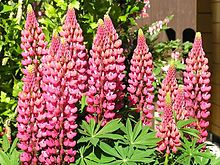Ballochorie
As ballochorie , ballistochory ( Greek βάλλειν ballein , German ' to throw' and χώρα chora , German 'place, area' ) or ball autochory and bolochory , one describes the mostly independent, autochore but also allochore , through the action of external forces, the spread of plant seeds Tossing away. These include slingshot, splash, catapult, torsion and explosion fruits (ballistic fruits).
A number of plants are able to move their diaspores to another place independently ( scattered fruit , self-spreading). To do this, some plants use mechanisms that throw the seeds away. This happens through automatic, sudden and explosive spinning movements (autoballochorie). These ballautochore plants are divided into two different types:
- With desiccation spreaders (Xeroballochoren) the tissue that dries out after ripening (tension in the pericarp ; swelling and de-swelling) of the fruit tears open explosively, so that the seeds are thrown out. For example, gorse and columbine and flat peas are plants that use this mechanism. Torsion, catapult, sling or explosion mechanisms are used here. They can also be subdivided further.
- Euxerobal holes; shearoid seeds, high pressure.
- Hemixeroballochoren; flat, light seeds, slight pressure, only partial expansion.
- In the case of juice pressure spreaders (hygroballocores), as the fruit ripens, the cell juice pressure increases (turgor ballists). This causes the walls of the fruit to swell, which burst explosively when a certain pressure is exceeded. The seed is z. T. thrown out several meters. The spray cucumber and balsam are among the best-known plants that use such a mechanism. Injection (recoil slings), explosion or slingshot mechanisms (lever or squeeze slingshot) are used here; in the first type, parts of the juicy fruit act as levers through which the seeds are thrown away, while in the second type, swelling occurs by squeezing swollen pieces of fruit).
But there are also plants that spread their seeds by being thrown away with the help of external influences or by animals, whereby these types are also counted among other spreading mechanisms:
- Animal ballists (zooballists) (zooballochorie) ( semachory )
- Windballisten (Anemoballisten) (Anemoballochorie) (Semachorie)
- Regenballisten (Hydroballisten) (Hydroballochorie) (Ball ombrochorie )
See also
literature
- FG Schroeder: Textbook of plant geography. Quelle & Meyer, 1998, ISBN 3-494-02235-6 , p. 34 ff, online at yumpu.com, accessed on September 2, 2017.
- E. Ulbrich : Biology of Fruits and Seeds ‹Karpobiology›. Springer, 1928, ISBN 978-3-642-51789-1 (reprint), pp. 40-50.
- W. Ruhland : Handbook of plant physiology. Volume XVII: Physiology of Movements , Part 2, Springer, 1962, ISBN 978-3-642-94853-4 (Reprint), pp. 716-829.
- Ballochorie in the lexicon of biology.
Individual evidence
- ^ Distribution type according to Düll and Kutzelnigg, 1986, and Müller-Schneider 1983, In: Publications of the Geobotanical Institute of the Eidg. Tech. University, Rübel Foundation, in Zurich, volume (year): 125 (1995), online
- ↑ Ecology. Vol. XIV, Brooklyn Botanic Garden, 1933, p. 226, archive.org .
- ↑ a b Marie Lhotská: contribution to the Termiologie Diasporologie. In: Folia Geobotanica et Phytotaxonomica. Volume 10, Issue 1, 1975, pp. 105-108, doi : 10.1007 / BF02855106 .

